Danielle Ellison's Blog
November 26, 2025
Local Sustainable Brands: Community Support and Benefits
Local sustainable brands are essential for nurturing community development by driving economic growth and supporting social initiatives. By prioritizing ethical practices and environmental responsibility, these brands not only create jobs but also enhance local culture and identity, making a positive impact on the community as a whole.
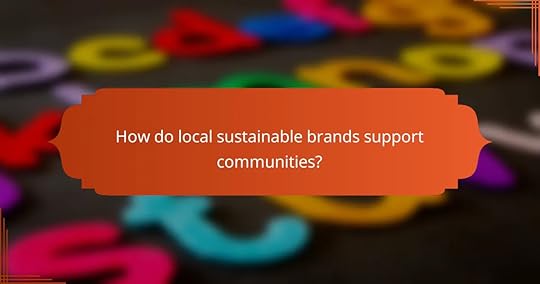
Local sustainable brands play a crucial role in supporting communities by fostering economic growth, promoting social initiatives, and enhancing local culture. They create jobs, invest in community projects, and uplift local artisans, contributing to a more resilient and vibrant local economy.
Job creation in local economiesLocal sustainable brands generate employment opportunities by hiring residents, which helps to reduce unemployment rates in the area. These jobs often range from production and retail to management positions, providing a variety of skill development opportunities.
Moreover, these brands typically prioritize fair wages and benefits, ensuring that employees earn a livable income. This focus on fair compensation helps to strengthen the local economy, as workers are more likely to spend their earnings within the community.
Investment in local initiativesMany local sustainable brands actively invest in community initiatives, such as environmental projects, educational programs, and health services. This investment can take the form of financial contributions, partnerships with local organizations, or volunteer efforts by employees.
For example, a sustainable clothing brand might sponsor local recycling programs or support workshops that teach sustainable practices. Such initiatives not only improve community well-being but also enhance the brand’s reputation and customer loyalty.
Promotion of local artisansLocal sustainable brands often collaborate with artisans to showcase their crafts, thereby promoting local culture and heritage. By sourcing products from local creators, these brands help to preserve traditional skills and provide artisans with a platform to reach wider audiences.
This collaboration can lead to increased sales for artisans, allowing them to thrive economically. Additionally, it fosters a sense of community pride and encourages consumers to support local craftsmanship over mass-produced goods.

Supporting local sustainable brands offers numerous advantages, including environmental, economic, and social benefits. By choosing these brands, consumers can contribute to a healthier planet while fostering community growth and identity.
Reduced carbon footprintLocal sustainable brands typically have a smaller carbon footprint compared to larger, global companies. This is due to shorter transportation distances for goods, which reduces greenhouse gas emissions associated with shipping. Additionally, many local brands prioritize eco-friendly practices in their production processes.
To maximize the environmental benefits, consumers can look for brands that source materials locally and utilize renewable energy in their operations. This not only supports sustainability but also encourages other businesses to adopt similar practices.
Enhanced community resilienceSupporting local sustainable brands strengthens community resilience by keeping money within the local economy. When consumers purchase from these brands, a larger portion of their spending stays in the community, which can lead to job creation and economic stability.
Moreover, local brands often engage in community initiatives, such as supporting local farmers or participating in environmental conservation efforts. This creates a network of support that can help communities adapt to economic changes and challenges.
Stronger local identityLocal sustainable brands contribute to a unique cultural identity by reflecting the values and traditions of the community. They often incorporate local materials, craftsmanship, and storytelling into their products, which fosters a sense of pride among residents.
By supporting these brands, consumers help preserve local heritage and promote a distinctive character that can attract tourism and new residents. This not only enhances community spirit but also encourages a collective commitment to sustainability and ethical practices.
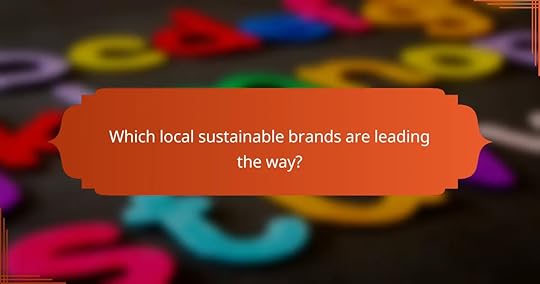
Several local sustainable brands are making significant strides in promoting eco-friendly practices and community support. These brands prioritize ethical sourcing, environmental responsibility, and social impact, setting examples for others in the industry.
PatagoniaPatagonia is renowned for its commitment to environmental sustainability and ethical manufacturing. The brand uses recycled materials in its products and actively supports grassroots environmental organizations through its 1% for the Planet initiative.
Customers can feel good about their purchases, knowing that Patagonia invests in initiatives that protect natural resources. The company also encourages repairs and recycling, promoting a circular economy.
EverlaneEverlane focuses on transparency in its supply chain, offering customers detailed information about the factories where their products are made. This commitment to ethical practices ensures fair wages and safe working conditions for workers.
With a strong emphasis on quality and timeless design, Everlane aims to reduce waste by encouraging consumers to buy less but better. Their pricing model reflects the true cost of production, making sustainable fashion accessible.
Local RootsLocal Roots is a community-driven brand that emphasizes sourcing ingredients and materials from local farmers and artisans. By supporting local economies, they foster a sense of community while reducing the carbon footprint associated with transportation.
Customers can enjoy fresh, seasonal products while knowing their purchases directly benefit local producers. This approach not only supports sustainable practices but also strengthens community ties and promotes local culture.
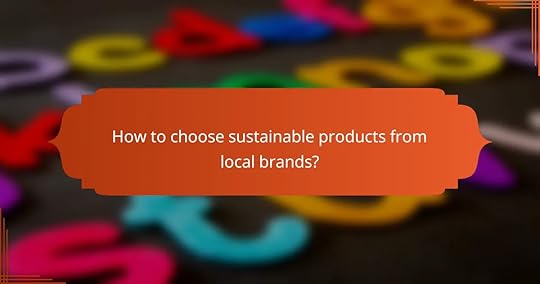
Choosing sustainable products from local brands involves evaluating their sourcing practices, checking for certifications, and assessing their community involvement. These factors help ensure that your purchases support environmentally friendly practices and contribute positively to the local economy.
Evaluate sourcing practicesWhen selecting sustainable products, start by examining the sourcing practices of local brands. Look for companies that prioritize local materials, as this reduces transportation emissions and supports nearby economies. Brands that use organic, fair trade, or recycled materials are often more sustainable.
Consider asking brands about their supply chain transparency. A responsible brand should be willing to share information about where and how their materials are sourced. This can include details about labor practices and environmental impact.
Check for certificationsCertifications can serve as a reliable indicator of a brand’s commitment to sustainability. Look for labels such as Fair Trade, USDA Organic, or Global Organic Textile Standard (GOTS). These certifications often require adherence to strict environmental and social standards.
Keep in mind that not all certifications are created equal. Research what each certification entails and ensure it aligns with your values. Some brands may have their own sustainability claims, so verify these against recognized standards.
Assess community involvementCommunity involvement is a key aspect of sustainable local brands. Brands that actively engage with their communities often contribute to local development and social well-being. Look for brands that participate in local initiatives, support local charities, or collaborate with other local businesses.
Additionally, consider how a brand impacts its community economically. Brands that hire locally and invest in community projects tend to have a more positive overall effect. Engaging with these brands not only supports sustainability but also fosters a stronger local economy.
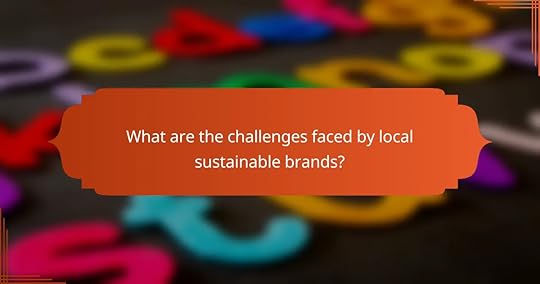
Local sustainable brands encounter several significant challenges that can hinder their growth and impact. These include fierce competition from larger corporations, limited access to funding and resources, and the need for greater consumer awareness and education about sustainability.
Competition with larger corporationsLocal sustainable brands often struggle to compete with larger corporations that benefit from economies of scale, extensive marketing budgets, and established distribution channels. This competition can make it difficult for smaller brands to gain visibility and attract customers.
To stand out, local brands should focus on their unique selling propositions, such as local sourcing, ethical practices, and community engagement. Building strong relationships with customers through storytelling and transparency can also help differentiate them from larger competitors.
Access to funding and resourcesSecuring funding is a common hurdle for local sustainable brands, as they may lack the financial backing that larger companies have. Traditional banks may be hesitant to lend to small businesses, especially those focused on sustainability, due to perceived risks.
Local brands can explore alternative funding options such as crowdfunding, grants from sustainability-focused organizations, or partnerships with local investors who share their values. Networking within the community can also lead to resource-sharing opportunities that can alleviate some financial burdens.
Consumer awareness and educationMany consumers may not fully understand the benefits of supporting local sustainable brands, which can limit their purchasing decisions. Raising awareness about the environmental and social impacts of consumer choices is crucial for these brands.
Local sustainable brands should invest in educational campaigns that highlight the importance of sustainability and the positive effects of supporting local economies. Collaborating with community organizations and participating in local events can also enhance visibility and foster consumer engagement.
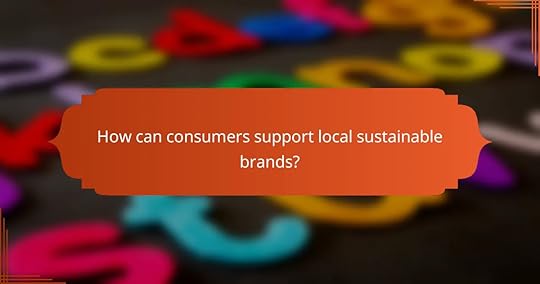
Consumers can support local sustainable brands by making conscious purchasing decisions and engaging with their communities. This not only boosts local economies but also fosters a sense of connection and responsibility towards the environment.
Shop at local marketsShopping at local markets is a direct way to support sustainable brands. These markets often feature products made by local artisans and farmers who prioritize eco-friendly practices. By purchasing from these vendors, consumers can ensure their money stays within the community and promotes sustainable practices.
When visiting local markets, look for organic produce, handmade goods, and products with minimal packaging. This reduces waste and encourages vendors to maintain sustainable practices. Additionally, consider shopping during peak hours to support the market’s popularity and sustainability.
Participate in community eventsEngaging in community events is another effective way to support local sustainable brands. Events such as farmers’ markets, eco-fairs, and workshops often showcase local businesses and their sustainable offerings. Participating in these events helps raise awareness and fosters a community spirit around sustainability.
To maximize your impact, volunteer at or attend events that focus on sustainability education or local product demonstrations. This not only supports local brands but also connects you with like-minded individuals who share your commitment to sustainable living.
November 25, 2025
Tencel vs. Bamboo: Which Is Better and When to Use
When comparing Tencel and bamboo fabrics, it’s essential to consider their unique properties and environmental impacts. Tencel, known for its softness and durability, is produced through a sustainable closed-loop process, making it a more eco-friendly choice. In contrast, bamboo offers natural antibacterial qualities and requires fewer pesticides, making it beneficial for specific applications. Understanding these differences can help you choose the right fabric for your needs.

Tencel is generally considered more sustainable than bamboo due to its closed-loop production process, which minimizes waste and uses less water. However, bamboo has its own environmental benefits, such as requiring fewer pesticides and less water during growth.
Tencel is made from sustainably sourced wood pulpTencel, also known as lyocell, is derived from sustainably sourced wood pulp, primarily from eucalyptus trees. The production process involves dissolving the wood pulp in a non-toxic solvent, which is then recycled in a closed-loop system, significantly reducing environmental impact.
This method not only conserves resources but also ensures that the fibers are biodegradable. Brands that produce Tencel often adhere to strict sustainability standards, such as the Forest Stewardship Council (FSC) certification, which promotes responsible forest management.
Bamboo requires less water and pesticidesBamboo is known for its rapid growth and ability to thrive without the need for chemical pesticides or fertilizers. This makes it an attractive option for sustainable fabric production. Bamboo can grow in a variety of climates and typically requires less water compared to traditional cotton crops.
However, the sustainability of bamboo fabric can be compromised during processing. Many bamboo textiles undergo chemical treatments that can negate some of their environmental benefits. It���s essential to look for brands that utilize eco-friendly methods, such as mechanical processing, to maintain the sustainability of bamboo fabrics.

Tencel and bamboo fabrics differ primarily in their softness, durability, and natural properties. Tencel, a branded fiber made from sustainably sourced wood pulp, tends to be softer and more durable, while bamboo offers natural antibacterial qualities that can be beneficial for certain applications.
Tencel is softer and more durableTencel fibers are known for their exceptional softness, making them a popular choice for clothing and bedding. The manufacturing process involves a closed-loop system that recycles water and solvents, resulting in a smooth texture that feels luxurious against the skin.
Additionally, Tencel is more durable than bamboo, maintaining its strength even after multiple washes. This durability makes it suitable for items that require frequent laundering, such as activewear and sheets, where longevity is a priority.
Bamboo has natural antibacterial propertiesBamboo fabric is renowned for its natural antibacterial properties, which can help reduce odors and keep garments fresher for longer. This quality makes bamboo a great option for activewear and undergarments, where hygiene is essential.
Moreover, bamboo is highly absorbent and moisture-wicking, making it comfortable to wear in warm climates. However, it is generally less durable than Tencel, so while it offers unique benefits, it may not withstand heavy use as well as Tencel does.

Choose Tencel when you prioritize softness, moisture-wicking properties, and eco-friendliness in your textiles. Tencel, made from sustainably sourced wood pulp, often outperforms bamboo in terms of comfort and environmental impact.
For luxury bedding and clothingTencel is an excellent choice for luxury bedding and clothing due to its silky texture and breathability. It drapes beautifully, making it ideal for high-end garments and sheets that feel soft against the skin.
Additionally, Tencel’s moisture-wicking abilities help regulate body temperature, enhancing comfort during sleep or wear. This makes it particularly suitable for those who seek a premium experience in their textiles.
When durability is a priorityWhen durability is essential, Tencel stands out for its strength compared to bamboo. Tencel fibers are less prone to fraying and fading, ensuring that your items last longer, even with regular use and washing.
Moreover, Tencel is resistant to wrinkles and static, making it a practical option for everyday wear. If you need fabrics that maintain their quality over time, Tencel is a reliable choice.

Bamboo is often the better choice when prioritizing eco-friendliness and affordability in fabric options. Its rapid growth and minimal pesticide use make it a sustainable resource, while its lower production costs can lead to more budget-friendly apparel.
For eco-friendly activewearBamboo fabric is an excellent option for eco-friendly activewear due to its natural properties and sustainable production methods. It is biodegradable, requires less water than cotton, and is often produced without harmful chemicals. This makes it a popular choice for environmentally conscious consumers looking for workout gear.
When selecting bamboo activewear, look for certifications like OEKO-TEX or GOTS to ensure the fabric meets environmental standards. Additionally, consider brands that emphasize sustainable practices in their manufacturing processes.
When seeking affordabilityBamboo textiles are typically more affordable than many alternatives, including Tencel, due to lower production costs and the abundance of bamboo as a raw material. This makes bamboo a practical choice for consumers who want quality without breaking the bank.
When shopping for bamboo clothing, compare prices across different retailers to find the best deals. Keep an eye out for sales or discounts, as bamboo products can often be found at competitive prices, especially in bulk purchases.

Tencel and bamboo fabrics have different care requirements that can affect their longevity and performance. Tencel is generally easier to care for, while bamboo may need more attention to maintain its quality.
Tencel is machine washable and quick-dryingTencel is machine washable, making it convenient for everyday use. It typically withstands regular washing cycles without losing its softness or structural integrity.
Additionally, Tencel dries quickly, which can be a significant advantage for those who need to wash and wear items frequently. This quick-drying property helps prevent mold and mildew, especially in humid environments.
Bamboo may require special washing instructionsBamboo fabrics often require more delicate care to preserve their natural fibers. It is advisable to wash bamboo items on a gentle cycle with cold water to avoid damage.
Some bamboo products may also need air drying rather than machine drying to maintain their shape and softness. Always check the care label for specific instructions, as improper washing can lead to shrinkage or loss of quality.

Tencel products typically cost more than bamboo products due to the more complex manufacturing process and the quality of the fibers. While both materials are eco-friendly, consumers should consider their budget and the intended use when choosing between them.
Tencel products tend to be more expensiveTencel, made from sustainably sourced wood pulp, involves a more intricate production process that contributes to its higher price point. Prices for Tencel items can range from moderate to high, often starting in the low tens of USD for basic products and going up significantly for luxury items.
When purchasing Tencel, consider the long-term value. Its durability and softness can justify the investment, especially for bedding and clothing that will be used frequently. Look for certifications like OEKO-TEX to ensure quality and sustainability.
Bamboo products are generally budget-friendlyBamboo products are often more affordable than Tencel, making them a popular choice for budget-conscious consumers. Prices for bamboo items can start as low as a few USD, which appeals to those looking for eco-friendly options without breaking the bank.
While bamboo is generally less expensive, it’s important to check the quality of the product. Some bamboo fabrics can be blended with other materials, which may affect their feel and durability. Look for 100% bamboo or high-quality blends to ensure you���re getting a good deal.

Tencel and bamboo fabrics have distinct properties that affect their performance in various climates. Tencel is known for its breathability and moisture-wicking abilities, making it suitable for humid conditions, while bamboo excels in providing a cooling effect during hot weather.
Tencel is breathable and moisture-wickingTencel, made from sustainably sourced wood pulp, is designed to be highly breathable. This quality allows air to circulate, helping to regulate body temperature and keep you comfortable in warm and humid environments.
Additionally, Tencel’s moisture-wicking properties draw sweat away from the skin, promoting quick evaporation. This feature is particularly beneficial for active individuals or those living in tropical climates, as it helps maintain dryness and comfort throughout the day.
Bamboo is cooler in hot weatherBamboo fabric is naturally cool to the touch, making it an excellent choice for hot weather. Its unique structure allows for better airflow, which can help lower body temperature during sweltering days.
Moreover, bamboo has inherent moisture-absorbing qualities, which means it can absorb sweat and moisture without feeling damp. This makes bamboo clothing a practical option for summer wear, especially in regions with high temperatures and humidity levels.

Some of the top brands for Tencel and Bamboo products include Lenzing, Eucalypso, and Boody. These brands are known for their quality materials, sustainable practices, and a range of products from bedding to clothing.
Top Tencel BrandsWhen looking for Tencel products, consider brands like Lenzing, which is the original manufacturer of Tencel fibers. Their products often feature high-quality sheets and clothing made from sustainably sourced wood pulp. Eucalypso is another notable brand, offering luxurious bedding that emphasizes comfort and eco-friendliness.
Top Bamboo BrandsFor bamboo products, Boody is a standout brand, known for its soft, breathable clothing made from organic bamboo. Another reputable option is Cariloha, which specializes in bamboo-based bedding and apparel, highlighting both sustainability and comfort. These brands often focus on eco-conscious practices while delivering quality products.
Factors to Consider When Choosing BrandsWhen selecting brands for Tencel or Bamboo products, consider factors such as sustainability certifications, product range, and customer reviews. Look for certifications like OEKO-TEX or FSC, which indicate responsible sourcing and manufacturing practices. Additionally, check for a variety of products that meet your specific needs, whether it���s clothing, bedding, or towels.
Price can also be a consideration; Tencel products may range from mid to high price points, while bamboo items can vary widely, often being more affordable. Always compare features and benefits to ensure you���re getting the best value for your investment.
Minimalism in Sustainable Fashion: Benefits, Trends and Consumer Appeal
Minimalism in sustainable fashion promotes a thoughtful approach to clothing consumption, emphasizing quality over quantity. By prioritizing fewer, high-quality items, consumers can significantly reduce waste and environmental impact while enjoying greater satisfaction from their purchases. This trend reflects a growing awareness of sustainability and a desire for more meaningful, versatile wardrobe choices.

Minimalism in sustainable fashion offers several advantages, including reduced waste, lower environmental impact, and enhanced consumer satisfaction. By focusing on fewer, high-quality items, consumers can make more conscious choices that benefit both the planet and their wallets.
Reduced environmental impactMinimalism significantly lowers the environmental footprint of fashion by promoting the use of fewer resources. This approach leads to less waste, as consumers are encouraged to buy only what they truly need, reducing the volume of discarded clothing in landfills.
Additionally, minimalistic brands often prioritize sustainable materials and ethical production methods, which further mitigates pollution and resource depletion. By choosing minimalist fashion, consumers can contribute to a more sustainable industry.
Cost savings for consumersAdopting a minimalist wardrobe can lead to substantial cost savings for consumers. By investing in a few versatile, high-quality pieces instead of numerous fast-fashion items, individuals can reduce their overall spending on clothing.
Moreover, minimalist fashion often emphasizes timeless styles that remain in vogue longer, decreasing the need for frequent purchases. This approach not only saves money but also encourages smarter financial decisions regarding clothing.
Enhanced quality and durabilityMinimalism promotes the purchase of high-quality garments that are built to last. Instead of focusing on quantity, minimalist fashion encourages consumers to seek out well-constructed items made from durable materials.
These quality pieces often withstand wear and tear better than cheaper alternatives, leading to a longer lifespan and reduced need for replacements. Investing in durable clothing can ultimately save consumers money and reduce waste.
Promotion of ethical labor practicesMany minimalist fashion brands prioritize ethical labor practices, ensuring fair wages and safe working conditions for their employees. By supporting these brands, consumers can contribute to a more equitable fashion industry.
Choosing ethically produced clothing aligns with the values of minimalism, as it emphasizes quality and responsibility over mass production. This shift helps to foster a more humane approach to fashion, benefiting workers globally.
Encouragement of mindful consumptionMinimalism encourages consumers to adopt a mindset of mindful consumption, focusing on intentional purchases rather than impulsive buying. This shift in perspective helps individuals evaluate their needs and make more thoughtful choices about their wardrobe.
By embracing a minimalist approach, consumers can cultivate a deeper appreciation for their clothing, leading to more sustainable habits. This practice not only benefits the environment but also enhances personal satisfaction with one’s wardrobe.

Minimalism is influencing sustainable fashion by promoting simplicity, quality, and longevity in clothing choices. This approach encourages consumers to invest in fewer, versatile pieces that reduce waste and environmental impact.
Rise of capsule wardrobesCapsule wardrobes consist of a limited selection of essential clothing items that can be mixed and matched. This trend allows individuals to create numerous outfits from a small number of pieces, emphasizing quality over quantity. By curating a capsule wardrobe, consumers can streamline their fashion choices and reduce the frequency of new purchases.
To build a capsule wardrobe, focus on versatile basics such as neutral tops, classic bottoms, and a few statement accessories. Aim for around 20-30 pieces that reflect your personal style and can transition between seasons.
Popularity of second-hand shoppingSecond-hand shopping has gained traction as consumers seek sustainable alternatives to fast fashion. Thrift stores, online resale platforms, and vintage shops offer unique clothing options while minimizing the demand for new production. This trend not only supports sustainability but also allows individuals to express their personal style creatively.
When shopping second-hand, consider checking local thrift stores or using apps like Depop and Poshmark. Look for high-quality items that can withstand wear and tear, ensuring longevity in your wardrobe.
Growth of eco-friendly brandsThe rise of eco-friendly brands reflects a growing consumer demand for sustainable fashion. These brands prioritize ethical production practices, use of organic materials, and environmentally friendly processes. By choosing eco-conscious labels, consumers can support businesses that align with their values.
When selecting eco-friendly brands, look for certifications such as GOTS (Global Organic Textile Standard) or Fair Trade. Research the brand’s commitment to sustainability and transparency in their supply chain to make informed purchasing decisions.

Consumers increasingly view minimalism in sustainable fashion as a desirable approach that emphasizes quality over quantity. This perception is driven by a growing awareness of environmental issues and a desire for more meaningful consumption choices.
Increased demand for transparencyConsumers are seeking greater transparency from brands regarding their production processes and sourcing of materials. They want to know where their clothing comes from and how it is made, which aligns with the principles of minimalism and sustainability.
Brands that openly share information about their supply chains and environmental impact tend to attract more loyal customers. This transparency not only builds trust but also encourages responsible purchasing decisions.
Preference for timeless designsMinimalism in fashion often translates to a preference for timeless designs that can be worn across multiple seasons. Consumers are moving away from fast fashion trends in favor of classic pieces that offer versatility and longevity.
Investing in high-quality, minimalist clothing reduces the need for frequent replacements, aligning with sustainable practices. Items like a well-fitted blazer or a simple dress can serve as staples in a wardrobe for years.
Desire for personalized shopping experiencesToday’s consumers are looking for personalized shopping experiences that cater to their individual styles and needs. This trend is particularly evident in the minimalist fashion sector, where curated collections and bespoke options are gaining popularity.
Brands that offer customization or tailored recommendations can enhance customer satisfaction and loyalty. Providing a unique shopping experience not only meets consumer desires but also reinforces the minimalist ethos of thoughtful consumption.

Consumers should evaluate minimalist fashion brands based on their material sourcing, brand transparency, and product longevity. These criteria help ensure that the choices made align with sustainable practices and ethical standards.
Material sourcing and sustainabilityWhen assessing material sourcing, look for brands that prioritize organic, recycled, or sustainably sourced materials. Common sustainable fabrics include organic cotton, Tencel, and recycled polyester. Brands that disclose their sourcing practices often demonstrate a commitment to reducing environmental impact.
Consider certifications such as Global Organic Textile Standard (GOTS) or OEKO-TEX, which indicate adherence to sustainability standards. These certifications can provide assurance that the materials used are not only eco-friendly but also safe for consumers.
Brand transparency and ethicsTransparency in business practices is crucial when selecting minimalist fashion brands. Look for companies that openly share information about their supply chain, labor practices, and environmental impact. Brands that provide detailed insights into their operations are often more trustworthy.
Ethical considerations also include fair labor practices and equitable wages for workers. Brands that are members of organizations like the Ethical Trading Initiative (ETI) or Fair Trade Certified demonstrate a commitment to ethical standards in their production processes.
Product longevity and versatilityMinimalist fashion emphasizes durability and versatility, so consider how long a product is likely to last and how many different ways it can be styled. High-quality materials and construction often lead to longer-lasting garments, reducing the need for frequent replacements.
Choose items that can be easily mixed and matched with other pieces in your wardrobe. This approach not only maximizes utility but also minimizes consumption, aligning with the principles of minimalism and sustainability.

Minimalist fashion brands often emphasize sustainability, ethical production, and timeless designs, setting them apart in the competitive fashion landscape. Their appeal lies in a growing consumer demand for environmentally friendly practices and quality over quantity.
Comparison of Everlane and ReformationEverlane and Reformation are two prominent minimalist fashion brands that prioritize transparency and sustainability. Everlane focuses on providing essential wardrobe staples with a commitment to ethical manufacturing, while Reformation emphasizes trendy, feminine designs made from eco-friendly materials.
In terms of pricing, Everlane generally offers lower price points, making it accessible to a broader audience. Reformation, on the other hand, tends to be positioned at a higher price range, reflecting its focus on sustainable fabrics and fashion-forward styles.
Both brands have strong online presences and engage with consumers through social media. Everlane’s straightforward approach to pricing and production transparency appeals to budget-conscious shoppers, while Reformation attracts those looking for stylish, eco-conscious options.
B Corporation Certification: Ethical Standards, Impact and Brand Trust
B Corporation Certification is a powerful tool for businesses seeking to enhance their brand trust by showcasing a commitment to high ethical standards in social and environmental performance. By meeting rigorous criteria for accountability and transparency, certified companies signal to consumers their dedication to making a positive impact on stakeholders, which can influence purchasing decisions and foster customer loyalty.

B Corporation Certification enhances brand trust by demonstrating a company’s commitment to social and environmental performance, accountability, and transparency. This certification signals to consumers that a business meets rigorous ethical standards, which can significantly influence purchasing decisions.
Increased consumer loyaltyCompanies with B Corporation Certification often experience increased consumer loyalty. Customers are more likely to support brands that align with their values, particularly those focused on sustainability and social responsibility. This loyalty can translate into repeat business and positive word-of-mouth referrals.
To cultivate this loyalty, businesses should actively communicate their B Corp status and the impact of their practices. Engaging storytelling about their ethical journey can resonate well with consumers, fostering a deeper connection.
Improved corporate reputationAchieving B Corporation Certification can significantly enhance a company’s corporate reputation. It positions the brand as a leader in ethical business practices, which can attract media attention and positive public perception. This improved reputation can also differentiate a company in competitive markets.
To maintain this reputation, businesses should consistently uphold the standards required for certification and transparently report on their progress. Regularly updating stakeholders on initiatives and outcomes can reinforce trust and credibility.
Attraction of ethical investorsB Corporation Certification can attract ethical investors who prioritize sustainability and social impact in their investment decisions. These investors often seek companies that demonstrate a commitment to responsible practices, making B Corps appealing options.
To attract these investors, companies should highlight their B Corp status in investment pitches and provide clear data on their social and environmental impact. Building a robust impact report can serve as a valuable tool to showcase commitment and results, making the business more attractive to potential investors.

B Corporation Certification requires companies to meet rigorous ethical standards that assess their social and environmental performance. These standards focus on accountability, transparency, and the overall impact of a business on its stakeholders, including employees, customers, and the community.
Social and environmental performance metricsTo achieve B Corporation Certification, businesses must evaluate their social and environmental performance through a comprehensive assessment. This includes metrics related to employee benefits, community engagement, and environmental impact. Companies typically score in a range from 0 to 200, with a minimum score of 80 required for certification.
Examples of performance metrics include energy usage, waste management practices, and community investment. Companies can improve their scores by implementing sustainable practices, such as reducing carbon footprints or enhancing employee welfare programs.
Accountability and transparency requirementsB Corporations must adhere to strict accountability and transparency standards, which include making their performance metrics publicly available. This transparency builds trust with consumers and stakeholders, as it allows them to see how the company measures up against its ethical commitments.
Additionally, companies are required to incorporate stakeholder interests into their governance structures. This means considering the impact of business decisions not just on shareholders, but also on employees, customers, and the environment. Regular reporting and updates on social and environmental performance are essential to maintain certification and foster ongoing improvement.

B Corporation Certification significantly enhances a business’s reputation by demonstrating a commitment to social and environmental performance. This certification can lead to improved brand trust, customer loyalty, and overall business success.
Positive community engagementB Corporations often prioritize community involvement, which fosters strong relationships with local stakeholders. By engaging in initiatives such as local sourcing, charitable contributions, and volunteer programs, these businesses create a positive impact that resonates with consumers.
For example, a B Corporation might partner with local nonprofits to support education or environmental sustainability projects, enhancing its community presence and reputation. This engagement not only benefits the community but also attracts customers who value socially responsible practices.
Enhanced employee satisfactionEmployees at B Corporations typically experience higher job satisfaction due to the company’s commitment to ethical practices and a positive workplace culture. This focus on social responsibility often translates into better employee retention and productivity.
Companies may implement policies that promote work-life balance, diversity, and inclusivity, which can lead to a more motivated workforce. As a result, businesses may see lower turnover rates and increased employee loyalty, contributing to long-term success.
Access to new marketsB Corporation Certification can open doors to new markets, particularly among consumers who prioritize ethical and sustainable brands. Many customers actively seek out B Corporations, believing they align with their values.
Additionally, some retailers and distributors prefer to partner with certified companies, providing B Corporations with access to exclusive sales channels. This can lead to increased revenue opportunities and a broader customer base, particularly in regions where sustainability is a growing concern.

Businesses can achieve B Corporation Certification by meeting rigorous standards of social and environmental performance, accountability, and transparency. The process involves completing an assessment, adhering to legal requirements, and submitting documentation for verification.
Complete the B Impact AssessmentThe B Impact Assessment is a comprehensive tool that evaluates a company’s impact on its workers, community, environment, and customers. Businesses must score a minimum number of points to qualify for certification, typically in the range of 80 to 200 points, depending on their industry.
To prepare, companies should gather data on their practices, policies, and outcomes. This may include employee benefits, community engagement initiatives, and environmental sustainability efforts. Regularly reviewing and updating practices can help improve scores over time.
Meet legal accountability requirementsTo achieve B Corporation Certification, businesses must meet specific legal accountability requirements that ensure they consider stakeholder interests in their decision-making. This often involves amending corporate governing documents to reflect a commitment to social and environmental goals.
In many jurisdictions, this may require adopting a legal structure that aligns with B Corp principles, such as a benefit corporation or a flexible purpose corporation. Companies should consult legal experts to understand the implications and necessary steps for compliance.
Submit documentation for verificationAfter completing the B Impact Assessment and meeting legal requirements, businesses must submit documentation for verification. This process involves providing evidence to support claims made in the assessment, such as policies, reports, and other relevant documentation.
Verification typically includes a review by B Lab, the nonprofit that certifies B Corporations, which may also involve an on-site review or interviews. Companies should be prepared to address any questions and provide additional information as needed to ensure a smooth verification process.

The costs associated with B Corporation Certification can vary significantly based on the size and revenue of the business. Generally, companies should budget for application fees, annual renewal fees, and potential consultation expenses to successfully achieve and maintain certification.
Application feesApplication fees for B Corporation Certification typically range from a few hundred to several thousand dollars, depending on the company’s revenue. For example, smaller businesses may pay around $1,000, while larger corporations could face fees exceeding $5,000. This fee is a one-time cost incurred when submitting the initial application.
Annual renewal feesAfter obtaining certification, businesses must pay annual renewal fees to maintain their B Corp status. These fees are usually based on the company’s revenue and can range from a few hundred to several thousand dollars each year. It’s essential to budget for these recurring costs to ensure continued compliance with B Corporation standards.
Consultation expensesMany companies choose to hire consultants to help navigate the certification process, which can incur additional costs. Consultation expenses can vary widely, often ranging from a few hundred to several thousand dollars, depending on the complexity of the business and the level of support needed. Engaging a consultant can streamline the application process but should be weighed against the overall budget for certification.

To achieve B Corporation Certification, businesses must meet specific ethical standards and demonstrate a commitment to social and environmental performance. This includes fulfilling requirements related to minimum revenue, operational transparency, and overall impact on stakeholders.
Minimum revenue requirementsB Corporation Certification does not impose a strict minimum revenue threshold, but companies typically need to generate sufficient income to support the certification process and ongoing compliance. Many businesses seeking certification often have annual revenues in the low tens of thousands to millions of dollars.
It’s essential to consider that the certification process involves costs, including application fees and potential consulting services. Therefore, businesses should ensure they have the financial capacity to invest in the certification while maintaining their operational viability.
Operational transparencyOperational transparency is a key component of B Corporation Certification, requiring companies to openly disclose their practices, policies, and impact metrics. This includes sharing information about governance, employee treatment, environmental practices, and community engagement.
To demonstrate transparency, businesses should prepare to provide documentation and data that reflect their operations and impact. This may involve publishing sustainability reports or maintaining an accessible online presence that outlines their commitments and achievements. Companies that prioritize transparency often build greater trust with consumers and stakeholders.
Fair Trade Certification: Identifying Brands and Ethical Practices
Fair Trade certification plays a crucial role in promoting ethical practices in trade by ensuring that producers receive fair wages and work in safe conditions. By identifying brands that display the Fair Trade Certified label, consumers can make informed choices that support sustainable farming methods and community development. This certification not only enhances consumer trust but also encourages a shift towards more responsible purchasing decisions in the marketplace.

To identify Fair Trade certified brands in the USA, look for products that display the Fair Trade Certified label. This certification ensures that the producers receive fair wages and work under safe conditions, promoting sustainable practices and community development.
Certified brands listSeveral well-known brands are Fair Trade certified, including Ben & Jerry’s, Equal Exchange, and Divine Chocolate. These brands commit to ethical sourcing and support for farmers and workers in developing countries. Checking the Fair Trade Certified website can provide an updated list of certified brands.
Additionally, many smaller brands and local businesses may also carry Fair Trade products. Look for local coffee shops or grocery stores that prioritize ethical sourcing, as they often feature Fair Trade certified items.
Online retailers with Fair Trade productsNumerous online retailers specialize in Fair Trade products, making it easier to shop ethically. Websites like Amazon, Fair Trade USA, and Ten Thousand Villages offer a wide range of Fair Trade certified items, from coffee to clothing. Always check the product descriptions for the Fair Trade certification to ensure authenticity.
Many larger retailers, such as Target and Walmart, also carry Fair Trade products in their online stores. Use filters or search terms like “Fair Trade” to quickly locate these items.
Brand transparency initiativesBrand transparency initiatives are crucial for ensuring ethical practices in Fair Trade. Many certified brands publish detailed reports on their sourcing practices, labor conditions, and community impact. This information can often be found on their websites under sections dedicated to sustainability or corporate responsibility.
Look for brands that engage in third-party audits and provide transparency about their supply chains. This commitment to openness helps consumers make informed choices and supports the overall integrity of Fair Trade practices.

Fair Trade certification offers numerous advantages, primarily aimed at promoting ethical practices in trade. It ensures that producers receive fair compensation, supports sustainable farming methods, and enhances consumer trust in brands committed to social responsibility.
Improved wages for farmersOne of the most significant benefits of Fair Trade certification is the assurance of improved wages for farmers. Certified producers typically receive a minimum price for their goods, which is often higher than the market rate, helping them achieve a more stable income.
This financial security allows farmers to invest in their communities and improve their living conditions. For example, Fair Trade coffee farmers may earn around 20-30% more than their non-certified counterparts, enabling them to afford better education and healthcare for their families.
Environmental sustainability practicesFair Trade certification promotes environmental sustainability by encouraging farmers to adopt eco-friendly practices. These practices include organic farming, crop rotation, and reduced use of harmful pesticides, which contribute to healthier ecosystems.
By adhering to these sustainable methods, certified producers not only protect the environment but also enhance the quality of their products. For instance, Fair Trade cocoa farmers often implement agroforestry techniques that preserve biodiversity while improving soil health.

Fair Trade certification significantly influences consumer choices by promoting ethical purchasing decisions. It encourages buyers to support brands that prioritize fair labor practices and sustainable sourcing, ultimately affecting market demand.
Increased demand for ethical productsThe rise in Fair Trade certification has led to a noticeable increase in demand for ethical products. Consumers are increasingly seeking out brands that align with their values, often willing to pay a premium for goods that ensure fair wages and safe working conditions for producers.
For example, Fair Trade coffee and chocolate are often priced higher than conventional options, reflecting the commitment to ethical practices. This trend indicates a shift in consumer behavior, where ethical considerations are becoming a primary factor in purchasing decisions.
Consumer awareness of sourcing practicesFair Trade certification has heightened consumer awareness regarding sourcing practices. Shoppers are now more informed about the origins of their products and the conditions under which they are made, leading to a demand for transparency from brands.
Many consumers actively research brands to ensure they adhere to ethical standards, often looking for Fair Trade labels as a sign of responsible sourcing. This awareness not only affects individual purchasing choices but also pressures companies to adopt more ethical practices to meet consumer expectations.

Fair Trade certification is based on specific criteria that ensure ethical practices in production and trade. Key factors include fair pricing, community development, and environmental sustainability, which collectively promote equitable trading relationships.
Minimum price guaranteesMinimum price guarantees are a fundamental aspect of Fair Trade certification, ensuring that producers receive a baseline price for their goods. This price is set to cover the cost of sustainable production and provide a living wage, protecting farmers from volatile market fluctuations.
For example, coffee producers might receive a guaranteed minimum price of around $1.40 per pound, which can increase if market prices rise. This stability helps farmers invest in their communities and improve their livelihoods.
Community development fundsCommunity development funds are another critical component of Fair Trade certification, designed to support local projects that benefit the community. A portion of the profits from Fair Trade sales is allocated to these funds, which can be used for education, healthcare, or infrastructure improvements.
Typically, these funds amount to a fixed premium, often around $0.20 per pound of product sold. This investment fosters long-term growth and empowers communities to address their unique challenges, enhancing overall quality of life.

Fair Trade brands encounter several significant challenges that can hinder their growth and market presence. Key issues include intense competition from non-certified brands and widespread consumer misconceptions about the Fair Trade label.
Market competition from non-certified brandsFair Trade brands often compete against non-certified products that may be cheaper and more readily available. These non-certified brands can undercut prices, making it difficult for consumers to justify the higher cost of Fair Trade items, even when they offer ethical benefits.
Many consumers prioritize price over ethical considerations, leading to a preference for non-certified options. This trend can diminish the market share of Fair Trade brands, despite their commitment to sustainable and equitable practices.
Consumer misconceptions about Fair TradeMisunderstandings about what Fair Trade certification entails can significantly impact consumer behavior. Some shoppers may believe that all Fair Trade products are prohibitively expensive or that the certification guarantees superior quality, which is not always the case.
Additionally, many consumers are unaware of the specific benefits associated with Fair Trade, such as improved wages for farmers and sustainable farming practices. Educating consumers about these aspects is crucial for increasing demand and supporting Fair Trade brands.

Supporting Fair Trade practices in local communities involves actively engaging with brands and initiatives that prioritize ethical sourcing and sustainable practices. This can be achieved through participation in events, collaborations with local businesses, and promoting awareness of Fair Trade products.
Local Fair Trade eventsParticipating in local Fair Trade events is a great way to support ethical practices and connect with like-minded individuals. These events often include markets, workshops, and educational sessions that highlight the importance of Fair Trade and showcase local artisans and producers.
Look for events in your area by checking community boards, social media, or local Fair Trade organizations. Many cities host annual fairs or festivals that celebrate Fair Trade, providing opportunities to purchase goods directly from producers and learn about their stories.
Partnerships with local businessesForming partnerships with local businesses that support Fair Trade can amplify your impact. Collaborate with cafes, shops, and markets that prioritize Fair Trade products, encouraging them to stock ethically sourced items and promote them to their customers.
Consider organizing joint promotions or events with these businesses to raise awareness and drive sales of Fair Trade products. This not only supports ethical practices but also strengthens community ties and fosters a culture of sustainability.

Emerging trends in Fair Trade certification focus on expanding the scope of certified products and increasing consumer awareness. Brands are increasingly adopting ethical practices, driven by consumer demand for transparency and sustainability in their purchasing decisions.
Increased focus on sustainabilityFair Trade certification is evolving to include a stronger emphasis on environmental sustainability. Brands are now required to adopt practices that minimize their ecological footprint, such as using organic materials and reducing waste. This shift reflects a growing consumer preference for products that not only support fair labor practices but also protect the planet.
Technology integrationAdvancements in technology are enhancing transparency in Fair Trade certification. Blockchain and traceability tools allow consumers to verify the origins of products, ensuring they meet Fair Trade standards. This technological integration helps brands build trust with consumers who are increasingly concerned about ethical sourcing.
Expansion into new marketsFair Trade certification is expanding beyond traditional products like coffee and chocolate into new markets, including fashion and cosmetics. This diversification allows consumers to make ethical choices across a broader range of products. Brands entering these markets often highlight their commitment to Fair Trade principles to attract socially conscious buyers.
Consumer education and engagementThere is a growing emphasis on educating consumers about Fair Trade practices and the impact of their purchases. Brands are using social media and community events to engage consumers, sharing stories about the producers behind their products. This engagement fosters a deeper connection between consumers and the ethical practices of the brands they support.
Organic Cotton: Benefits, Sustainability and Quality
Organic cotton is a sustainable and eco-friendly alternative to conventional cotton, offering numerous benefits for both consumers and the environment. By avoiding harmful chemicals during cultivation, it not only promotes healthier skin but also reduces environmental harm, contributing to the preservation of ecosystems. Additionally, organic cotton is known for its superior quality, resulting in softer and more durable fibers that align with a conscious lifestyle.

Organic cotton offers numerous benefits, including being gentler on the skin, reducing environmental harm, and providing a more sustainable choice for consumers. Its cultivation avoids harmful chemicals, making it a healthier option for both people and the planet.
Hypoallergenic propertiesOrganic cotton is less likely to cause allergic reactions compared to conventional cotton. This is primarily due to the absence of synthetic pesticides and fertilizers, which can irritate sensitive skin. As a result, organic cotton is often recommended for individuals with allergies or skin conditions.
Environmental impact reductionThe production of organic cotton significantly reduces environmental impact by avoiding toxic chemicals and promoting biodiversity. Organic farming practices improve soil health and reduce water usage, which is crucial in areas facing water scarcity. Additionally, organic cotton farming contributes to lower greenhouse gas emissions compared to conventional methods.
Softness and comfortOrganic cotton is known for its exceptional softness and comfort, making it a preferred choice for clothing and home textiles. The fibers are typically longer and more durable, which enhances the overall feel of the fabric. Consumers often find organic cotton garments to be more breathable, providing a comfortable wearing experience.
Durability and longevityOrganic cotton tends to be more durable than conventional cotton due to the absence of harsh chemicals that can weaken fibers. This durability translates into longer-lasting products, reducing the need for frequent replacements. Investing in organic cotton items can lead to cost savings over time as they withstand wear and tear better.
Support for sustainable farmingChoosing organic cotton supports sustainable farming practices that benefit both farmers and the environment. Organic farming promotes crop rotation and natural pest control, which helps maintain ecosystem balance. By purchasing organic cotton products, consumers contribute to a market that values ethical production and supports farmers committed to sustainability.
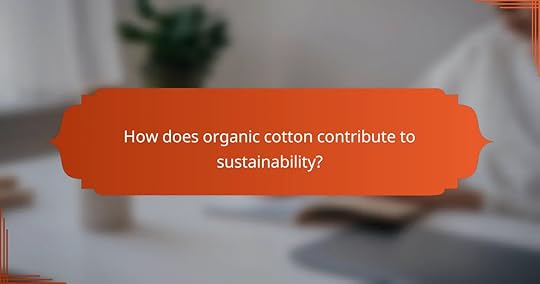
Organic cotton significantly enhances sustainability by reducing the environmental impact of cotton farming. It promotes eco-friendly practices that protect ecosystems, conserve resources, and improve the quality of soil and water.
Reduced pesticide useOrganic cotton farming eliminates synthetic pesticides, which can harm wildlife and contaminate water supplies. Instead, it relies on natural pest control methods, such as beneficial insects and crop rotation, to manage pests effectively.
This reduction in chemical usage not only protects the environment but also improves the health of farmworkers and nearby communities. Farmers often report lower rates of pesticide-related health issues when switching to organic practices.
Water conservation practicesOrganic cotton cultivation typically employs water conservation techniques that minimize water usage. Methods such as rain-fed irrigation and mulching help retain soil moisture, reducing the need for additional water resources.
By using these practices, organic cotton farms can use up to 50% less water compared to conventional cotton farms, making it a more sustainable choice in regions where water scarcity is a concern.
Soil health improvementOrganic cotton farming enhances soil health through practices like crop rotation, cover cropping, and organic fertilizers. These methods increase soil fertility and biodiversity, leading to more resilient ecosystems.
Healthy soil not only supports better cotton yields but also contributes to carbon sequestration, helping mitigate climate change. Farmers can see improved soil quality over time, which benefits future crops and the environment alike.
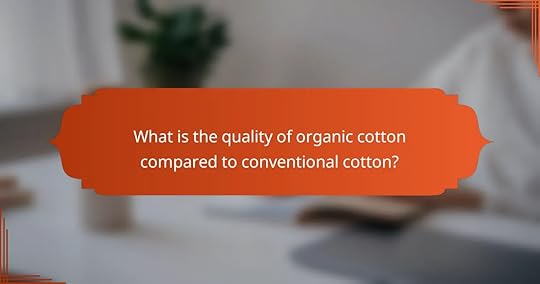
Organic cotton is generally considered to be of higher quality than conventional cotton due to its natural cultivation methods and lack of synthetic chemicals. This results in softer fibers, greater durability, and a more environmentally friendly production process.
Fiber strength and resilienceOrganic cotton fibers tend to be stronger and more resilient than those of conventional cotton. This is largely due to the absence of harsh chemicals during the growing process, which can weaken the fibers. As a result, organic cotton products often have a longer lifespan and maintain their shape better over time.
When comparing the two, organic cotton can withstand more washing cycles without significant degradation. This makes it a practical choice for items that require frequent cleaning, such as bedding and clothing.
Breathability and moisture-wickingOrganic cotton is known for its excellent breathability and moisture-wicking properties. The natural fibers allow air to circulate freely, helping to regulate body temperature and keep the wearer comfortable. This is particularly beneficial in warm climates or during physical activity.
Additionally, organic cotton absorbs moisture effectively, drawing sweat away from the skin. This feature enhances comfort and reduces the likelihood of skin irritation, making it suitable for sensitive skin types.
Color retention and dyeingWhen it comes to color retention, organic cotton often outperforms conventional cotton. The natural dyes used in organic cotton production are less likely to fade over time compared to synthetic dyes. This results in vibrant colors that last longer, even after multiple washes.
Moreover, the dyeing process for organic cotton typically involves fewer harmful chemicals, which is better for both the environment and the consumer. When choosing organic cotton products, look for those dyed with GOTS-certified (Global Organic Textile Standard) dyes for assurance of quality and sustainability.

Some of the best brands for organic cotton products include Patagonia, People Tree, and Organic Basics. These companies are recognized for their commitment to sustainability, quality, and ethical production practices.
PatagoniaPatagonia is renowned for its high-quality outdoor apparel made from organic cotton. The brand prioritizes environmental responsibility and uses materials that are certified organic, ensuring minimal impact on the planet.
When choosing Patagonia, consider their wide range of products, from t-shirts to jackets, all designed for durability and performance. Their transparency about sourcing and production processes helps consumers make informed choices.
People TreePeople Tree specializes in sustainable fashion, offering a variety of organic cotton clothing that is both stylish and eco-friendly. The brand is Fair Trade certified, which means it adheres to strict social and environmental standards.
With a focus on ethical production, People Tree ensures that workers receive fair wages and safe working conditions. Their collections often feature unique designs, making it easy to find fashionable pieces that support sustainable practices.
Organic BasicsOrganic Basics is dedicated to creating essentials from organic cotton, emphasizing simplicity and sustainability. Their products range from underwear to activewear, all made with eco-friendly materials.
By choosing Organic Basics, consumers can expect high-quality items that are designed to last. The brand also promotes a circular economy through initiatives like recycling programs, encouraging responsible consumption.

Choosing organic cotton products involves looking for certifications, understanding the sourcing, and assessing the quality of the fabric. Prioritize items that are certified organic by recognized standards to ensure they meet environmental and health criteria.
Look for certificationsCertifications such as GOTS (Global Organic Textile Standard) or OEKO-TEX�� Standard 100 indicate that the cotton is grown without harmful chemicals and is processed in an environmentally friendly manner. These labels provide assurance that the product meets strict ecological and social criteria.
Assess the qualityQuality in organic cotton can vary, so consider the thread count and texture. Higher thread counts typically indicate a softer, more durable fabric. Look for smoothness and a natural feel, avoiding products that feel coarse or rough.
Consider the sourcingResearch where the organic cotton is sourced from, as this can affect sustainability practices. Regions like India and Turkey are known for organic cotton production, but ensure that the farms adhere to ethical labor practices. Products made from locally sourced organic cotton may also have a lower carbon footprint.
Impact of Certifications: Brand Reputation, Consumer Perception and Trust
Certifications play a vital role in shaping brand reputation and consumer trust in the e-commerce landscape. By signaling adherence to industry standards and quality, they enhance consumer perception and influence purchasing decisions. As a result, certified products often enjoy a competitive edge, fostering long-term relationships between brands and consumers.

Certifications significantly enhance brand reputation in e-commerce by establishing trust and credibility with consumers. They signal adherence to industry standards and quality, which can influence purchasing decisions and foster long-term relationships.
Enhanced credibilityCertifications serve as third-party endorsements that validate a brand’s claims about its products or services. For example, a certification from a recognized authority can assure customers that the brand meets specific quality or safety standards. This external validation can be crucial in competitive markets where consumers are cautious about their choices.
Brands that display certifications prominently on their websites or product packaging often experience a boost in consumer confidence. This credibility can lead to increased conversion rates, as customers feel more secure in their purchasing decisions.
Increased customer loyaltyWhen customers trust a brand due to its certifications, they are more likely to become repeat buyers. Loyalty is often built on the assurance that the brand consistently delivers quality products or services. For instance, brands with organic or fair-trade certifications may attract consumers who prioritize ethical considerations in their purchases.
To cultivate loyalty, brands should not only obtain relevant certifications but also communicate their significance effectively. Engaging customers through stories about the certification process can deepen their connection to the brand.
Positive brand associationsCertifications can create positive associations in consumers’ minds, linking the brand to values such as quality, safety, and sustainability. For example, a brand certified for environmentally friendly practices may attract eco-conscious consumers, enhancing its overall image. These associations can differentiate a brand in a crowded marketplace.
Brands should leverage these positive associations in their marketing strategies. Highlighting certifications in advertising campaigns can reinforce the brand’s commitment to quality and ethical practices, further solidifying its reputation among target audiences.

Consumer perception plays a crucial role in the effectiveness of certifications, as it influences how brands are viewed in terms of quality and reliability. A positive perception can enhance trust and encourage consumers to choose certified products over non-certified alternatives.
Trust in certified brandsTrust in certified brands is often rooted in the assurance that these products meet specific standards of quality and safety. Certifications act as a signal to consumers that the brand is committed to maintaining high operational standards, which can significantly bolster consumer confidence.
For example, certifications like ISO or organic labels can lead consumers to believe that the brand adheres to rigorous guidelines. This trust can translate into brand loyalty, as customers are more likely to return to brands they perceive as credible and trustworthy.
Influence on purchasing decisionsCertifications can heavily influence purchasing decisions by providing consumers with a clear basis for comparison. When faced with multiple options, consumers often gravitate towards certified products, believing they offer better quality or safety.
Research indicates that products with recognized certifications can see a sales increase ranging from 20% to 50% compared to non-certified counterparts. Brands should leverage this by prominently displaying certifications on packaging and marketing materials to enhance visibility and appeal.

Certifications build consumer trust by providing a reliable indication of product quality and adherence to industry standards. When consumers see a certification, they often feel more confident in their purchasing decisions, knowing that the product has met specific criteria set by recognized authorities.
Transparency in product qualityCertifications enhance transparency by clearly communicating the quality and safety of products. For instance, organic certifications in food products assure consumers that the items are produced without synthetic pesticides or fertilizers. This transparency helps consumers make informed choices aligned with their values.
In sectors like electronics, certifications such as Energy Star indicate energy efficiency, allowing consumers to compare products easily based on environmental impact. This clarity can significantly influence purchasing behavior, as consumers increasingly prioritize sustainability.
Assurance of compliance with standardsCertifications provide assurance that products comply with established industry standards, which can vary by region. For example, in the European Union, CE marking indicates compliance with safety and health regulations, giving consumers confidence in the product’s reliability.
Moreover, certifications can serve as a competitive advantage. Companies that invest in obtaining certifications often differentiate themselves in the market, appealing to consumers who prioritize quality and safety. This can lead to increased brand loyalty and repeat purchases.

Key certifications that significantly influence brand reputation include ISO certifications, organic certifications, and Fair Trade certifications. These certifications help establish trust and credibility among consumers, enhancing a brand’s image and marketability.
ISO certificationsISO certifications are internationally recognized standards that demonstrate a company’s commitment to quality management, environmental responsibility, and operational efficiency. Achieving ISO certification can improve a brand’s reputation by showcasing its dedication to maintaining high standards.
Businesses should consider which ISO standards are relevant to their industry, such as ISO 9001 for quality management or ISO 14001 for environmental management. Obtaining these certifications often involves a rigorous audit process, which can be resource-intensive but ultimately leads to improved processes and customer satisfaction.
Organic certificationsOrganic certifications indicate that products are produced without synthetic fertilizers, pesticides, or genetically modified organisms. These certifications are crucial for brands in the food and agriculture sectors, as they appeal to health-conscious consumers and those concerned about environmental sustainability.
To obtain organic certification, companies must comply with specific regulations set by local authorities, such as the USDA in the United States or the EU Organic logo in Europe. Brands should ensure transparency in their supply chain and maintain detailed records to meet certification requirements.
Fair Trade certificationsFair Trade certifications ensure that producers receive fair compensation and work under safe conditions. This certification is particularly important for brands sourcing products from developing countries, as it promotes ethical practices and social responsibility.
Brands seeking Fair Trade certification must adhere to established standards, which often include paying a premium to farmers and investing in community development. By promoting Fair Trade products, companies can enhance their reputation among socially conscious consumers and differentiate themselves in a competitive market.

Certifications differ significantly across industries, reflecting the unique standards and consumer expectations within each sector. These variations influence brand reputation, consumer perception, and trust, making it essential for businesses to understand the specific certifications relevant to their field.
Food and beverage industryIn the food and beverage industry, certifications like USDA Organic, Non-GMO Project Verified, and HACCP are crucial for ensuring product safety and quality. These certifications not only comply with regulatory standards but also enhance consumer trust by signaling commitment to health and sustainability.
Brands should consider obtaining multiple certifications to appeal to a broader audience. For example, a product that is both organic and gluten-free can attract health-conscious consumers. However, maintaining these certifications requires ongoing compliance and regular audits, which can be resource-intensive.
Technology and electronicsIn technology and electronics, certifications such as CE marking, FCC compliance, and ISO 9001 play a vital role in demonstrating product safety and quality. These certifications help companies meet regulatory requirements and assure consumers that products have undergone rigorous testing.
Companies should prioritize certifications that align with their target markets. For instance, obtaining ENERGY STAR certification can appeal to environmentally conscious consumers, while ISO certifications can enhance credibility in B2B transactions. However, navigating the certification process can be complex and may require expert guidance.
Fashion and apparelThe fashion and apparel industry often relies on certifications like Fair Trade, GOTS (Global Organic Textile Standard), and OEKO-TEX to promote ethical practices and sustainable materials. These certifications can significantly enhance brand reputation by appealing to socially and environmentally aware consumers.
Brands should clearly communicate their certifications through marketing channels to build consumer trust. However, it���s essential to ensure that claims are substantiated, as misleading information can lead to backlash and damage to brand reputation. Regularly updating certifications can also help brands stay relevant in a fast-evolving market.

To obtain certifications, organizations typically need to meet specific criteria that demonstrate compliance with industry standards. These prerequisites often include implementing quality management systems, undergoing audits, and maintaining documentation that proves adherence to set guidelines.
Understanding certification standardsCertification standards serve as benchmarks that organizations must meet to gain official recognition in their industry. These standards can vary widely depending on the sector, such as ISO standards for manufacturing or organic certification for food products. Familiarizing oneself with the relevant standards is crucial for successful certification.
Organizations should assess their current practices against these standards to identify gaps. This may involve consulting with experts or utilizing resources from certification bodies to ensure all requirements are understood and met.
Investment in quality controlInvesting in quality control is essential for achieving and maintaining certifications. This investment often includes training staff, upgrading equipment, and implementing robust monitoring systems. The costs can vary, but organizations should expect to allocate a portion of their budget towards these improvements.
Effective quality control not only aids in certification but also enhances overall product reliability and customer satisfaction. Regular reviews and updates to quality processes can prevent lapses that might jeopardize certification status.

Brands can effectively leverage certifications to enhance their marketing strategies by showcasing their commitment to quality and compliance. Certifications serve as credible endorsements that can significantly influence consumer trust and brand reputation.
Enhancing brand reputationCertifications can elevate a brand’s reputation by demonstrating adherence to industry standards and best practices. When a brand is certified, it signals to consumers that it meets specific quality benchmarks, which can differentiate it from competitors.
For example, a food brand with organic certification can attract health-conscious consumers who prioritize natural ingredients. This not only enhances the brand’s image but also fosters loyalty among customers who value sustainability.
Influencing consumer perceptionConsumer perception is heavily influenced by certifications, as they provide assurance of quality and safety. Brands that display certifications often enjoy increased credibility, which can lead to higher purchase intent.
For instance, a technology company that holds ISO 9001 certification can be perceived as more reliable and efficient. This perception can translate into a competitive advantage in the marketplace, particularly in sectors where trust is paramount.
Building consumer trustCertifications play a crucial role in building consumer trust, as they serve as third-party validation of a brand’s claims. When consumers see recognized certifications, they are more likely to believe in the brand’s commitment to quality and ethical practices.
To maximize trust, brands should clearly communicate the significance of their certifications through marketing channels. For example, highlighting a Fair Trade certification can resonate with socially conscious consumers, reinforcing their trust in the brand’s values.
November 24, 2025
Fast Fashion vs. Sustainable Brands: Which Is Better and When to Use
The debate between fast fashion and sustainable brands revolves around production methods, environmental impact, and ethical practices. Fast fashion offers affordability and trendiness for those in need of quick, stylish options, while sustainable brands focus on long-term value and responsible practices. Understanding when to choose each can help consumers make informed decisions that align with their values and needs.
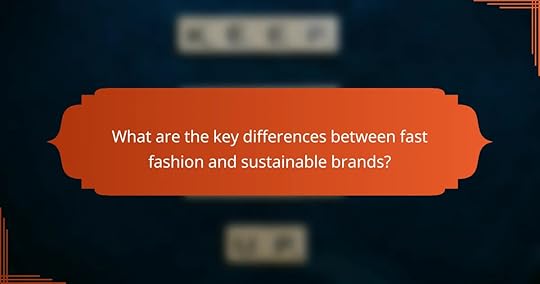
Fast fashion and sustainable brands differ primarily in their production methods, environmental impact, labor practices, price points, and brand transparency. Fast fashion focuses on quick production and low costs, while sustainable brands prioritize ethical practices and environmental responsibility.
Production methodsFast fashion brands typically use mass production techniques that prioritize speed and low costs. This often involves synthetic materials and processes that can be harmful to the environment. In contrast, sustainable brands emphasize eco-friendly materials and ethical production methods, such as using organic cotton or recycled fabrics.
When choosing between the two, consider the lifecycle of the clothing. Sustainable brands often invest in quality, leading to longer-lasting products, while fast fashion items may wear out quickly, necessitating more frequent replacements.
Environmental impactThe environmental impact of fast fashion is significant, contributing to pollution, waste, and high carbon emissions. These brands often produce large quantities of clothing that end up in landfills within a short period. Sustainable brands, however, aim to minimize their ecological footprint through responsible sourcing and reduced waste.
For example, many sustainable brands implement practices like using biodegradable packaging and ensuring that their supply chains are environmentally friendly. Choosing sustainable options can help reduce your personal impact on the planet.
Labor practicesLabor practices in fast fashion are often criticized for poor working conditions, low wages, and lack of worker rights. Many fast fashion companies outsource production to countries with lax labor laws, leading to exploitation. In contrast, sustainable brands typically prioritize fair labor practices, ensuring that workers are paid fairly and work in safe conditions.
When evaluating brands, look for certifications such as Fair Trade or Ethical Trade, which indicate a commitment to better labor practices.
Price pointsFast fashion is known for its low price points, making trendy clothing accessible to a wide audience. However, these low prices often come at the expense of quality and ethical practices. Sustainable brands generally have higher price points due to the cost of ethical sourcing and production, but they offer better quality and longevity.
Consider your budget and how often you purchase clothing. Investing in a few high-quality sustainable pieces may be more economical in the long run compared to frequently buying cheap fast fashion items.
Brand transparencyBrand transparency varies significantly between fast fashion and sustainable brands. Fast fashion companies often lack clear information about their supply chains and production processes. In contrast, sustainable brands typically provide detailed information about their sourcing, manufacturing, and labor practices.
When shopping, look for brands that openly share their sustainability initiatives and supply chain information. This transparency can help you make informed choices that align with your values.

Fast fashion is a viable option when you need affordable clothing quickly and are looking for trendy styles. It allows consumers to keep up with current fashion trends without a significant financial commitment.
Budget constraintsIf you are working within a tight budget, fast fashion offers a way to purchase clothing at lower prices, often ranging from $10 to $50 per item. This affordability makes it easier to refresh your wardrobe without overspending.
However, be mindful of the potential trade-offs in quality. While the initial cost is low, fast fashion items may not last long, leading to more frequent replacements and potentially higher long-term costs.
Trendy itemsFast fashion is ideal for acquiring trendy items that may only be in style for a short period. Retailers frequently update their collections to reflect the latest fashion trends, making it easy to find current styles.
For example, if you want to wear a specific look seen on social media or at a fashion show, fast fashion retailers often replicate these styles quickly and affordably, allowing you to stay fashionable without a hefty investment.
Short-term useFast fashion is suitable for occasions where clothing will be worn only a few times, such as parties or events. If you need an outfit for a single event, fast fashion allows you to find something stylish without worrying about long-term wear.
Consider items like costumes or seasonal outfits that you may not wear again. In these cases, spending less on trendy pieces makes sense, as you can enjoy the look without the commitment of a sustainable investment.

It is better to choose sustainable brands when you prioritize long-term value, ethical practices, and high-quality materials. These brands often align with environmentally friendly practices and support fair labor conditions, making them a worthwhile investment for conscious consumers.
Long-term investmentInvesting in sustainable brands typically means spending more upfront but saving in the long run. These items are designed to last longer, reducing the need for frequent replacements. Consider that a well-made sustainable garment may cost 50-100% more than fast fashion, but its lifespan can be several times longer.
When evaluating your wardrobe, think about the cost-per-wear. A sustainable piece worn frequently can end up being more economical than cheaper alternatives that wear out quickly.
Ethical considerationsChoosing sustainable brands often reflects a commitment to ethical production practices. These brands usually prioritize fair wages, safe working conditions, and environmentally responsible materials. By supporting them, you contribute to a more equitable fashion industry.
Look for certifications like Fair Trade or GOTS (Global Organic Textile Standard) when selecting sustainable options. These labels indicate adherence to ethical standards, ensuring your purchase supports positive social and environmental impacts.
Quality and durabilitySustainable brands focus on high-quality materials and craftsmanship, which often results in more durable products. Unlike fast fashion, which may use low-quality fabrics that degrade quickly, sustainable clothing is made to withstand regular wear and tear.
When shopping, examine the fabric composition and stitching details. Natural fibers like organic cotton, linen, or Tencel are often more durable and environmentally friendly than synthetic alternatives. Investing in quality pieces can enhance your wardrobe while reducing environmental impact.

Fast fashion typically offers lower prices compared to sustainable brands, making it more accessible for budget-conscious consumers. However, sustainable brands often provide higher quality and ethical production practices, which can justify their higher price points.
Fast fashion affordabilityFast fashion is known for its low prices, often ranging from a few dollars to low tens of dollars for trendy items. This affordability attracts consumers looking for the latest styles without a significant financial commitment. However, these low prices often come at the expense of quality and ethical labor practices.
Sales and promotions are common in fast fashion, allowing consumers to purchase multiple items at a fraction of the cost of sustainable brands. While this can be appealing, it can lead to overconsumption and waste, undermining the sustainability of fashion choices.
Sustainable brand pricingSustainable brands generally have higher price points, often starting in the low tens and going up to several hundred dollars for ethically produced garments. This pricing reflects the costs associated with sustainable materials, fair labor practices, and environmentally friendly production processes. Consumers are increasingly willing to invest in these brands for the value they provide.
While the initial investment may be higher, many sustainable brands focus on durability and timeless designs, which can lead to long-term savings. Shoppers should consider the overall value rather than just the upfront cost when evaluating sustainable options.
Cost-per-wear analysisCost-per-wear is a useful metric for evaluating the true value of clothing. To calculate it, divide the purchase price by the number of times you expect to wear the item. Fast fashion items may have a low upfront cost but can wear out quickly, leading to a higher cost-per-wear over time.
Sustainable brands, while pricier initially, often result in a lower cost-per-wear due to their durability and timeless appeal. Investing in a few high-quality pieces can be more economical in the long run compared to frequently replacing cheaper fast fashion items.

Fast fashion significantly harms the environment through excessive waste, resource depletion, and a high carbon footprint. These impacts arise from the rapid production cycles and low-cost materials that characterize the fast fashion industry.
Waste generationFast fashion contributes to massive waste generation, with millions of tons of clothing discarded each year. Many garments end up in landfills, where they can take decades to decompose, releasing harmful chemicals into the soil and water.
To mitigate waste, consumers can consider buying second-hand clothing or opting for brands that prioritize recycling and upcycling. Reducing impulse purchases and focusing on quality over quantity can also help decrease overall waste.
Resource depletionThe fast fashion industry heavily depletes natural resources, particularly water and raw materials. For instance, producing a single cotton t-shirt can require thousands of liters of water, straining local water supplies in many regions.
Choosing sustainable brands that use organic materials or recycled fabrics can help conserve resources. Additionally, supporting initiatives that promote sustainable agriculture can contribute to reducing resource depletion in the fashion sector.
Carbon footprintFast fashion has a substantial carbon footprint, primarily due to the energy-intensive processes involved in manufacturing and transportation. Estimates suggest that the fashion industry accounts for a significant percentage of global greenhouse gas emissions.
To lower your carbon footprint, consider purchasing from brands that utilize renewable energy sources and implement sustainable practices. Wearing clothes longer and opting for eco-friendly laundry methods can also contribute to reducing overall emissions associated with fashion consumption.

Shopping sustainably offers numerous advantages, including reduced environmental impact and support for ethical labor practices. By choosing sustainable brands, consumers can contribute to a healthier planet and promote fair working conditions.
Environmental impactSustainable shopping significantly lowers the environmental footprint associated with clothing production. This includes reduced water usage, lower carbon emissions, and less waste generated in landfills. For instance, sustainable brands often utilize eco-friendly materials and processes that minimize harm to ecosystems.
Support for ethical labor practicesWhen you shop sustainably, you often support brands that prioritize fair labor practices. Many sustainable companies ensure that their workers receive fair wages and work in safe conditions. This contrasts with fast fashion, where labor exploitation is more common, particularly in developing countries.
Quality and longevitySustainable clothing is typically made from higher-quality materials, leading to longer-lasting products. Investing in durable items can save money in the long run, as they do not need to be replaced as frequently as cheaper, fast fashion alternatives. For example, a well-made sustainable shirt may last several years, while a fast fashion piece might wear out within a season.
Personal values alignmentShopping sustainably allows consumers to align their purchases with their personal values. Many individuals are increasingly concerned about environmental issues and social justice, and choosing sustainable brands reflects these priorities. This alignment can enhance overall satisfaction with purchases and foster a sense of community among like-minded consumers.
November 20, 2025
Sustainable Clothing: Quick Outfits, Eco-Friendly Choices and Professional Style
Sustainable clothing provides a stylish solution for those seeking quick outfits while prioritizing eco-friendly choices. By selecting versatile pieces from brands like Patagonia and Reformation, you can effortlessly create professional looks that minimize environmental impact. Embracing sustainable fashion not only reduces your carbon footprint but also supports ethical labor practices and promotes durability in your wardrobe.
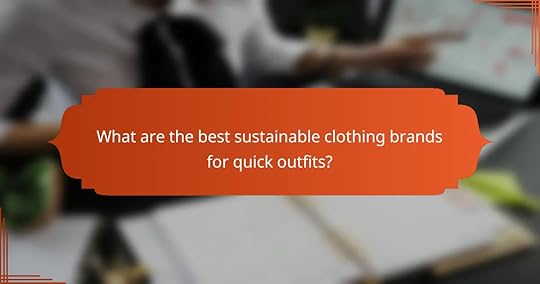
The best sustainable clothing brands for quick outfits combine eco-friendly materials with stylish designs, making it easy to dress sustainably. Brands like Patagonia, Everlane, Reformation, and People Tree offer versatile pieces that can be mixed and matched for various occasions.
Patagonia for casual wearPatagonia is renowned for its commitment to environmental sustainability and offers a range of casual wear that is both functional and stylish. Their clothing often features recycled materials and is designed for durability, making it ideal for everyday use.
Consider items like their organic cotton t-shirts and fleece jackets, which can be easily layered for comfort and style. When shopping, look for the Fair Trade Certified label, which ensures ethical labor practices.
Everlane for professional attireEverlane focuses on transparency and ethical production, providing a selection of professional attire that is chic and sustainable. Their pieces are designed to be timeless, allowing for easy integration into a work wardrobe.
Key items include their dress shirts and tailored trousers, which can be paired for a polished look. Everlane’s pricing is straightforward, with no hidden costs, making it easier to budget for sustainable fashion.
Reformation for trendy stylesReformation is a go-to brand for those seeking trendy styles without compromising on sustainability. They use eco-friendly fabrics and prioritize low-impact production methods, appealing to fashion-forward consumers.
Look for their dresses and tops that are perfect for both casual outings and dressier occasions. Reformation frequently updates its collections, so you can find fresh styles that align with current trends while supporting sustainable practices.
People Tree for ethical optionsPeople Tree is a pioneer in sustainable and fair trade fashion, offering a range of ethical clothing options. Their commitment to social responsibility ensures that workers are paid fairly and work in safe conditions.
Their collections include casual and formal wear, with an emphasis on organic cotton and natural dyes. When choosing People Tree, you can feel confident that your purchase supports ethical practices and environmental sustainability.

Creating eco-friendly outfits for work involves selecting sustainable materials, versatile styles, and accessories that enhance your professional appearance while minimizing environmental impact. Focus on building a wardrobe that allows for easy mixing and matching to maximize outfit options without excessive consumption.
Mix and match sustainable basicsStart with a foundation of sustainable basics like organic cotton shirts, recycled polyester blouses, and responsibly sourced trousers. Choose neutral colors and classic cuts that can easily be paired with various items in your wardrobe.
For instance, a simple black dress can be dressed up with a blazer for meetings or dressed down with a cardigan for casual Fridays. Aim for a capsule wardrobe of about 10-15 versatile pieces that can create multiple outfits.
Incorporate versatile accessoriesAccessories can transform a basic outfit into something polished and professional. Opt for items like a quality leather bag made from vegetable-tanned leather or a silk scarf that adds a pop of color without overwhelming your look.
Consider investing in a few key pieces, such as a statement necklace or a classic watch, that can be worn in different settings. This approach not only enhances your outfit but also reduces the need for multiple clothing items.
Choose sustainable fabricsSelect fabrics that are not only eco-friendly but also suitable for a professional environment. Look for materials like Tencel, hemp, or organic linen, which are known for their low environmental impact and durability.
When shopping, check for certifications like Global Organic Textile Standard (GOTS) or OEKO-TEX, which ensure that the fabrics meet specific sustainability criteria. Prioritize quality over quantity to ensure your clothing lasts longer, reducing waste and the need for frequent replacements.

Sustainable clothing offers numerous advantages, including a reduced environmental footprint, support for ethical labor practices, and enhanced durability. These benefits contribute to a more responsible and conscious approach to fashion.
Reduced environmental impactSustainable clothing significantly lowers the environmental impact of the fashion industry. By utilizing organic materials and eco-friendly production methods, brands can minimize water usage, chemical pollution, and waste generation.
For example, organic cotton uses about 90% less water than conventional cotton. Choosing brands that prioritize sustainable practices helps reduce the overall carbon footprint associated with clothing production.
Support for ethical labor practicesPurchasing sustainable clothing often means supporting brands that adhere to ethical labor practices. These companies typically ensure fair wages, safe working conditions, and respect for workers’ rights.
Look for certifications such as Fair Trade or GOTS (Global Organic Textile Standard), which indicate a commitment to ethical labor. This not only benefits workers but also fosters a more equitable fashion industry.
Long-lasting qualitySustainable clothing is designed to be durable and long-lasting, reducing the need for frequent replacements. High-quality materials and craftsmanship ensure that these garments withstand wear and tear over time.
Investing in a few well-made sustainable pieces can save money in the long run, as they often outlast cheaper, fast-fashion alternatives. Consider items made from materials like Tencel or recycled polyester for added longevity.

Choosing sustainable clothing for various occasions involves selecting materials and designs that minimize environmental impact while meeting the needs of the event. Consider factors such as fabric composition, sourcing practices, and the overall lifecycle of the garment.
Casual outings with organic cottonFor casual outings, organic cotton is an excellent choice due to its softness and breathability. Look for t-shirts, dresses, or shorts made from 100% organic cotton, which is grown without harmful pesticides and chemicals.
Pair organic cotton pieces with versatile accessories to elevate your look. For example, a simple organic cotton tee can be dressed up with a statement necklace or layered under a denim jacket for a relaxed yet stylish appearance.
Office wear with recycled materialsWhen selecting office wear, consider garments made from recycled materials such as polyester or nylon. These fabrics help reduce waste by repurposing plastic bottles and other materials, making them a sustainable option for professional attire.
Opt for tailored blazers, dress shirts, or slacks that incorporate recycled fabrics. Combining these pieces with classic footwear can create a polished look while supporting eco-friendly practices in the workplace.
Formal events with eco-friendly fabricsFor formal events, look for clothing made from eco-friendly fabrics like Tencel, hemp, or organic silk. These materials not only provide a luxurious feel but also have a lower environmental impact compared to conventional fabrics.
Consider dresses or suits crafted from these sustainable materials, and accessorize with biodegradable or vintage jewelry to enhance your outfit. This approach allows you to make a stylish statement while adhering to eco-conscious values.

When selecting sustainable clothing, focus on the materials used, the production processes, and the brand’s commitment to transparency. These criteria help ensure that your clothing choices are environmentally friendly and ethically produced.
Material sourcing and productionLook for clothing made from organic, recycled, or sustainably sourced materials. Fabrics like organic cotton, Tencel, and recycled polyester are better for the environment compared to conventional options. Additionally, consider the production methods; low-impact dyes and water-efficient processes can significantly reduce environmental harm.
Pay attention to local production as well. Clothing made closer to home often has a smaller carbon footprint due to reduced transportation emissions. Brands that prioritize local manufacturing may also support fair labor practices.
Brand transparency and certificationsChoose brands that are transparent about their supply chains and production practices. Look for certifications like GOTS (Global Organic Textile Standard), Fair Trade, or OEKO-TEX, which indicate adherence to specific environmental and social standards. These certifications can help you identify brands that genuinely prioritize sustainability.
Be cautious of greenwashing, where brands claim to be sustainable without substantial evidence. Researching a brand’s practices and reading customer reviews can provide insights into their true commitment to sustainability.

Styling sustainable clothing for a professional look involves selecting eco-friendly fabrics and tailoring them to fit your workplace environment. Focus on versatile pieces that can be mixed and matched to create polished outfits while minimizing environmental impact.
Choose versatile piecesSelect clothing items that can be easily paired with different outfits to maximize their use. For example, a well-fitted blazer made from organic cotton or recycled materials can elevate a simple blouse and trousers combination. Aim for neutral colors that can transition from day to night, ensuring you get the most out of each piece.
Incorporate sustainable fabricsUtilize fabrics like Tencel, hemp, and organic cotton, which are not only eco-friendly but also breathable and comfortable. These materials often have a professional appearance, making them suitable for office wear. Look for certifications like GOTS (Global Organic Textile Standard) to ensure the sustainability of your clothing choices.
Accessorize thoughtfullyAccessories can enhance your professional look while maintaining sustainability. Opt for items made from recycled materials or ethically sourced components. For instance, a leather-free bag made from recycled plastics can complement your outfit without compromising your eco-friendly values.
Focus on fit and tailoringProper fit is crucial for a professional appearance. Invest in tailoring for sustainable clothing to ensure it flatters your body shape and looks polished. A well-tailored garment can make even the simplest sustainable piece look sophisticated, allowing you to present yourself confidently in any professional setting.
Sustainable Fashion Trends: Staying Ahead in 2025
As we approach 2025, sustainable fashion trends are increasingly centered on innovative materials, digital advancements, and inclusive practices that emphasize environmental responsibility. These trends not only aim to reduce waste but also enhance consumer engagement and promote ethical consumption. By making conscious choices, consumers can significantly impact the fashion industry and support brands that prioritize sustainability.

The top sustainable fashion trends for 2025 focus on innovative materials, digital advancements, and inclusive practices that prioritize environmental responsibility. These trends aim to reduce waste, enhance consumer engagement, and promote a more ethical approach to fashion consumption.
Upcycled materialsUpcycled materials are gaining traction as brands look to minimize waste by repurposing existing textiles and products. This approach not only reduces the demand for new resources but also adds unique character to garments. For example, using leftover fabric scraps to create new clothing items can lead to one-of-a-kind pieces that appeal to eco-conscious consumers.
When considering upcycled materials, look for brands that clearly communicate their sourcing and production processes. Transparency is key, as it builds trust and ensures that the upcycled items truly contribute to sustainability goals.
Digital fashionDigital fashion is emerging as a revolutionary trend, allowing consumers to purchase virtual clothing for use in digital environments, such as social media or gaming. This trend significantly reduces the environmental impact associated with traditional garment production and distribution. Brands like The Fabricant are leading the way by offering digital-only collections that cater to a tech-savvy audience.
As digital fashion grows, consider how it can complement your wardrobe. Investing in virtual outfits can save money in the long run and reduce physical clutter while still allowing for personal expression in online spaces.
Eco-friendly dyesEco-friendly dyes are becoming essential in sustainable fashion, as brands seek alternatives to harmful chemical processes. Natural dyes derived from plants, minerals, and insects offer vibrant colors without the environmental toll of synthetic dyes. For instance, indigo from plants or turmeric for yellow hues are popular choices among eco-conscious designers.
When shopping, look for certifications or labels that indicate the use of eco-friendly dyes. This ensures that your clothing choices support sustainable practices and reduce harmful chemical runoff into waterways.
Slow fashion movementThe slow fashion movement emphasizes quality over quantity, encouraging consumers to invest in timeless pieces rather than fast, disposable fashion. This trend promotes thoughtful consumption, where items are designed to last and be cherished. Brands adopting this philosophy often focus on craftsmanship and sustainable materials.
To embrace slow fashion, consider building a capsule wardrobe with versatile pieces that can be mixed and matched. Prioritize brands that offer repair services or take-back programs to extend the life of your clothing and reduce waste.
Inclusive sizingInclusive sizing is a critical trend in sustainable fashion, aiming to cater to a diverse range of body types. Brands are increasingly recognizing the importance of offering extended size ranges to promote body positivity and accessibility. This shift not only meets consumer demand but also aligns with ethical practices by ensuring that all individuals can find clothing that fits well.
When shopping for sustainable fashion, support brands that prioritize inclusivity in their sizing. Look for those that provide detailed size guides and feedback from customers to ensure a better fit for everyone.

Consumers can adopt sustainable fashion practices by making conscious choices that reduce environmental impact. This includes shopping second-hand, supporting sustainable brands, participating in clothing swaps, and investing in quality pieces that last longer.
Shop second-handShopping second-hand is one of the most effective ways to embrace sustainable fashion. Thrift stores, online marketplaces, and consignment shops offer a wide variety of clothing at lower prices, reducing the demand for new production.
Look for local thrift shops or online platforms like eBay or Depop to find unique items. By purchasing pre-owned clothing, you not only save money but also contribute to reducing textile waste.
Choose sustainable brandsChoosing sustainable brands is crucial for supporting ethical practices in the fashion industry. Look for companies that prioritize eco-friendly materials, fair labor practices, and transparent supply chains.
Brands that are certified by organizations like Global Organic Textile Standard (GOTS) or Fair Trade are often more reliable. Research the brand���s sustainability initiatives and opt for those that align with your values.
Participate in clothing swapsClothing swaps are a fun and engaging way to refresh your wardrobe sustainably. By exchanging clothes with friends or community members, you can acquire new items without spending money or contributing to waste.
Organize a swap event in your area or join local groups that host these gatherings. This not only promotes sustainability but also fosters community connections.
Invest in quality piecesInvesting in quality pieces means selecting clothing that is durable and timeless. High-quality garments may have a higher upfront cost but tend to last longer, reducing the need for frequent replacements.
Focus on classic styles and versatile items that can be worn in multiple settings. This approach not only saves money in the long run but also minimizes your overall environmental footprint.

Several brands are at the forefront of sustainable fashion, focusing on eco-friendly materials, ethical production, and transparency. Notable leaders include Patagonia, Everlane, Reformation, and Allbirds, each with unique approaches to sustainability.
PatagoniaPatagonia is renowned for its commitment to environmental responsibility and ethical manufacturing. The brand uses recycled materials and organic cotton, significantly reducing its ecological footprint.
Additionally, Patagonia encourages customers to repair and recycle their gear, promoting a circular economy. Their “Worn Wear” program exemplifies this by offering trade-in options for used items.
EverlaneEverlane emphasizes transparency in its supply chain, providing detailed cost breakdowns for each product. This approach helps consumers understand the true cost of fashion and the ethical practices behind it.
The brand uses sustainable materials, such as recycled polyester and organic cotton, and is committed to reducing waste. Everlane’s “Choose What You Pay” model also allows customers to select from different price points based on their budget and the brand’s markup.
ReformationReformation focuses on stylish, eco-friendly clothing made from sustainable fabrics like Tencel and recycled materials. The brand’s commitment to sustainability is evident in its carbon-neutral practices and water conservation efforts.
Reformation also provides a detailed sustainability score for each item, helping consumers make informed choices. Their initiatives include a recycling program and a pledge to reduce waste in production.
AllbirdsAllbirds is known for its sustainable footwear made from natural materials such as merino wool and eucalyptus tree fibers. The brand prioritizes comfort and environmental impact, ensuring a minimal carbon footprint in its production processes.
Allbirds also focuses on transparency, sharing information about its supply chain and sustainability efforts. Their commitment to using renewable materials and reducing waste sets a benchmark in the footwear industry.

Sustainable fashion offers numerous benefits, including a reduced environmental footprint and improved social equity. By prioritizing eco-friendly materials and ethical labor practices, brands can contribute to a healthier planet and fairer working conditions.
Reduced environmental impactSustainable fashion significantly lowers the environmental impact of clothing production. This includes using organic materials, minimizing water consumption, and reducing carbon emissions throughout the supply chain.
For example, brands that utilize recycled fabrics can cut down on waste and energy use, often resulting in a reduction of up to 70% in water consumption compared to traditional methods. Choosing local production can further decrease transportation emissions.
Support for ethical labor practicesBy adopting sustainable practices, fashion brands can ensure fair wages and safe working conditions for their employees. This commitment to ethical labor practices helps combat exploitation and supports communities globally.
Brands that are transparent about their supply chains often engage in fair trade practices, ensuring that workers receive just compensation. Consumers can look for certifications like Fair Trade or GOTS (Global Organic Textile Standard) to identify brands that prioritize ethical labor.
Enhanced brand loyaltyConsumers increasingly prefer brands that demonstrate a commitment to sustainability and ethical practices. This trend can lead to enhanced brand loyalty, as customers feel a connection to companies that align with their values.
Brands that effectively communicate their sustainable initiatives often see a boost in customer retention. Engaging storytelling about the brand’s journey towards sustainability can further strengthen this loyalty, encouraging repeat purchases and positive word-of-mouth.

Consumers should evaluate sustainable fashion based on material sourcing, production processes, and overall environmental impact. These criteria help determine the sustainability of a brand and its products, guiding consumers toward more responsible choices.
Material sourcingMaterial sourcing refers to how and where the raw materials for clothing are obtained. Sustainable brands often prioritize organic, recycled, or upcycled materials that reduce environmental harm. Look for certifications like Global Organic Textile Standard (GOTS) or OEKO-TEX, which indicate responsible sourcing practices.
When assessing materials, consider the lifecycle impact. For instance, organic cotton uses significantly less water than conventional cotton, while recycled polyester diverts plastic waste from landfills. Aim for brands that transparently share their sourcing practices and the origins of their materials.
Production processesProduction processes encompass the methods used to manufacture clothing, which can greatly affect sustainability. Ethical brands typically employ low-impact techniques, minimize waste, and ensure fair labor practices. Investigate whether the brand adheres to standards like Fair Trade or has certifications that promote ethical production.
Pay attention to energy sources used in production. Brands that utilize renewable energy sources, such as solar or wind, contribute to lower carbon footprints. Additionally, consider the geographical location of production; local manufacturing can reduce transportation emissions and support local economies.



